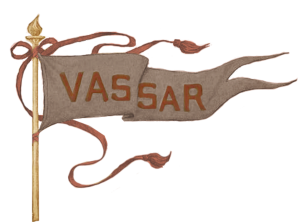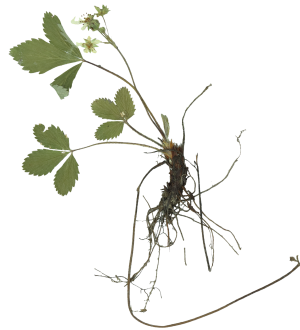1890 — 1966
A Saturday afternoon in early May. The elms and maples of
a former Raymond Avenue cast their shadows across a crusty
two—lane highway. Professors and their wives are out of
doors, rakes or hoes in hand, clearing the debris of a long
Poughkeepsie winter.
Suddenly, one is aware of an approaching figure--tall, slim,
distinguished, and correct; a figure decked out in wing col-
lar, grey ascot, cutaway coat, striped trousers, spats, and
upon his head a dark fedora set at a discreet angle.
Contemplating this figure, a stranger might surmise that
here was a man of fashion, a dilettante, whose delicate
hands touched nothing of the earth earthy, and who had
uttered his early cries within the confines of a dainty
cradle in a foreign city--Rome, Paris, or Teheran--attended
by servants who responded at once to his most inarticulate
wish.
Our stranger, however, would have been wrong on all counts:
no dilettante, but a good solid scholar of French literature,
whose publications, while not frequent, were important and
well-received; no aesthete, but a man who could grub in the
garden, hike twenty miles a day with the Adirondack Mountain '
Glub, dance until the wee hours of the morning, and put to-
gether an excellent and tasty Irish stew.
If he looked a man of fashion, as he did on this particular
Saturday afternoon, he was on his way no doubt, as indeed
he was, to afternoon tea at the home of a colleague. And,
alas, no-—neither Rome, nor Paris, nor Teheran, not even
New York, is to be honored as the birthplace of John
Richardson Miller, but Leominster, Massachusetts, a mill
town half way between Worcester and the New Hampshire border
where Miller pére for half a century cared for the sick,
brought innumerable people into the world and eased as many
out of it.
John Miller's childhood and youth are outside the pale of
our knowledge. For all we know, he may have been a barefoot
boy with cheeks of tan who went fishing on a summer's day,
a bamboo pole over his shoulder and a can of worms in his
hand.
JOHN RICHARDSON MILLER - continued
We do know that in the fall of 1909 John Miller entered
Williams College and that he graduated Phi Beta Kappa in
June, 1913; and that he remained another year at Williams
serving as an assistant in history and taking a Master of
Arts degree.
In this era of non-early specialization, John Miller became
an instructor in French, Latin, and algebra, at the Penn-Yan
Academy in central New York near the head of Keuka Lake.
The following year he moved on to the Washington University
Academy in St. Louis, thence to West Virginia University where
he taught the Romance languages--French and Spanish--until
1929.
In the meantime, he had obtained a Ph.D. at Harvard and
studied at the Sorbonne, the Residencia de Estudiantes in
Madrid, the University of Florence, the Middlebury French
School, and the Institut de Phonétique in Paris. Mr. Miller
also held in 1920-1921 a Parker Traveling Fellowship from
Harvard for research at the Bibliotheque Nationale. '
In the fall of 1930, John Miller and his wife joined Vassar's
French Department. Mrs. Miller was the former Maria Tastevin
whom Mr. Miller had first met at a meeting of the Modern
Language Association. Forsaking the cause of learning moment-
arily, John Miller and Maria Tastevin adjourned to a nearby
drugstore where, over a couple of banana-splits, the court-
ship really began. In due course they were married and shortly
thereafter, with Mrs. Miller, who was returning to Vassar Col-
lege, where she had taught from 1922 to 1928, he found his way
to Poughkeepsie.
John Miller's major publication was a 626-page book published
by the Johns Hopkins Press in 1942: Boileau en France au
dix-huitieme siecle. This work was very favorably reviewed
in American, French, and English journals. All the reviewers,
without exception, referred to this volume as an extremely
valuable reference work for students of the 18th Century.
Following the publication of this book, Mr. Miller was invited
at the suggestion of Henri Peyre of Yale to become a colla-
borator with A. F. B. Clark on the Boileau section of
A Critical Bibliography of French Literature.
In March 1946 Mr. Miller published in collaboration with
Eliot G. Fay a highly-regarded eleven-page critical biblio-
graphy of Antoine de Saint-Exupéry.
JOHN RICHARDSON MILLER - continued
In November of the same year, Mr. Miller published a success-
ful educational edition of Saint-Exupéry's Le Petit Prince.
This charming tale of the encounter of a wrecked aviator
and a little boy from another planet is widely used in the
United States, not only as a first reading text, but as an
example of a literary type in contemporary literature.
The Millers‘ last years at Vassar were darkened by the death
of their only child, Madeleine, a beautiful and talented
young woman who, after graduating from Vassar, had married a
Frenchman and lived in Paris. There was joy for them, however,
in the presence of a grandchild.
Mr. Miller, at that time Chairman of the French Department,
retired in 1955 and with Mrs. Miller left the United States
for their home in Paris. John Miller was always the most
hospitable of men; still, in the midst of an active social
life and a frequent attendance at the Paris theaters, John
Miller continued his scholarly work. In 1959, there appeared
his educational edition of Paul Vialar's Le Petit Garcon de
l'ascenseur. This unusual fantasy and Mr. Miller's excellent
introduction commended itself to teachers of French in this
country. It is still a widely used text.
Only once after his retirement did Mr. Miller return to the
United States. In 1963 he attended the 50th reunion of his
class at Williams. When he came to Poughkeepsie for a few
days, we saw him at various parties, gay, happy, full of
boyish spontaneity, and glad to be back among his old friends.
At one party, he appeared in his reunion costume--an outland-
ishly colored blazer and on his head, not a fedora, but a
beanie.
Sumer after summer in France, research leaves in France, a
French wife, and a daughter married to a Frenchman, could not
make a Frenchman out of the boy from Leominster, Massachusetts.
There was a facade, to be sure—=he spoke French with the best
of Frenchmen and he adapted well to life in France--but under-
neath the facade there was the New Englander. He loved France
but he had great pride in his New England background. With
Daniel Webster he could have said: "I shall enter on no
encomium upon Massachusetts; she needs none. There she is.
Behold her, and judge for yourselves."
John Miller died in Paris on January 27, 1966, at the age of
seventy-five.
Christiane Berkowe
Gordon Post
Ruth Venable, Chairman
XVII 61 - 62

